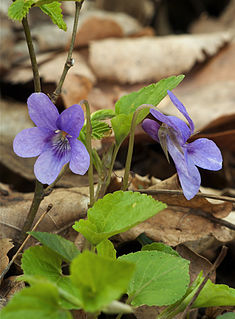
Viola is a genus of flowering plants in the violet family Violaceae. It is the largest genus in the family, containing between 525 and 600 species. Most species are found in the temperate Northern Hemisphere; however, some are also found in widely divergent areas such as Hawaii, Australasia, and the Andes.

Viola riviniana, the common dog-violet, is a species of flowering plant in the family Violaceae, native to Eurasia and Africa. It is also called wood violet and dog violet. It inhabits woodland edges, grassland and shady hedge banks. It is found in all soils except those which are acid or very wet.

Viola canadensis is a flowering plant in the Violaceae family. It is commonly known as Canadian white violet, Canada violet, tall white violet, or white violet. It is widespread across much of Canada and the United States, from Alaska to Newfoundland, south as far as Georgia and Arizona. It is a perennial herb and the Latin specific epithet canadensis means of Canada.

Viola sororia, known commonly as the common blue violet, is a short-stemmed herbaceous perennial plant that is native to eastern North America. It is known by a number of common names, including common meadow violet, purple violet, woolly blue violet, hooded violet, and wood violet. Its cultivar 'Albiflora' has gained the Royal Horticultural Society's Award of Garden Merit. This perennial plant species is distributed in the eastern half of the United States, Canada and a part of Eastern Mexico. Their native habitats are rich, moist woods, and swamps located in the eastern half of the United States and Canada.
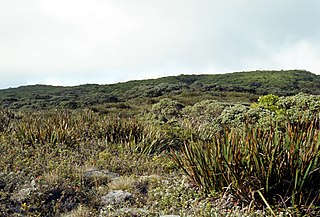
Pēpēʻōpae is a bog on the island of Molokaʻi in Hawaii.
Melicope puberula, the hairy melicope, is a species of plant in the family Rutaceae. It is endemic to the Hawaiian Islands. Like other Hawaiian Melicope, this species is known as alani. In 2010 it was added to the endangered species list of the United States.

Viola adunca is a species of violet known by the common names hookedspur violet, early blue violet, sand violet, and western dog violet. It is native to meadows and forests of western North America, Canada, and the northern contiguous United States.
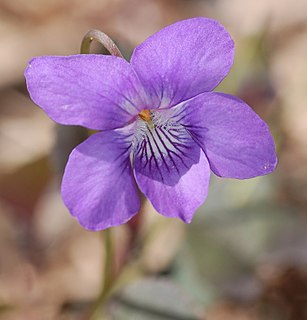
Viola labradorica, commonly known as alpine violet, American dog violet, dog violet or Labrador violet, is a perennial herbaceous flowering plant. It is native to Greenland, eastern Canada, and the eastern United States. The plant sold as Viola labradorica by nurseries is Viola riviniana.
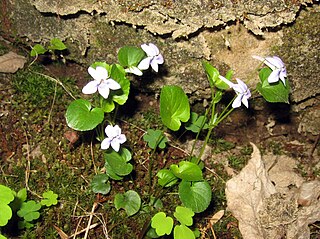
Viola rostrata, commonly called the long-spurred violet, is an herbaceous plant in the violet family (Violaceae). It is native to eastern North America, where it is found in Canada and the United States, primarily in the Northeastern, Midwestern, and Appalachian regions. Its natural habitat is acidic mesic forests, often growing near Tsuga canadensis.
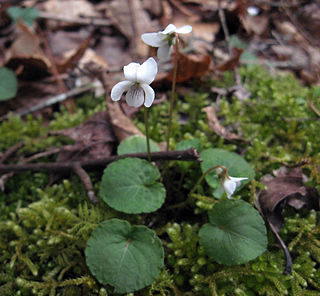
Viola blanda, commonly called the sweet white violet, is a flowering perennial plant in the Violet family (Violaceae). It is native to parts of south-eastern and south-central Canada and the eastern, and north-central, United States. Its natural habitat is in cool, mesic forests.
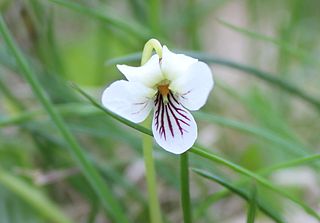
Viola macloskeyi is a flowering perennial plant in the violet family (Violaceae).

Viola nephrophylla syn. Viola nephrophylla Greene f. albinea (Farw.), Viola pratincola Greene, Viola retusa Greene ) is an annual or perennial forb in the Violet family (Violaceae) native to North America.

Viola pedatifida, known variously as prairie violet, crow-foot violet, larkspur violet, purple prairie violet, and coastal violet, is a perennial herbaceous plant in the Violet family (Violaceae). It is native to Canada and the United States.
Viola kauaensis is a rare species of flowering plant in the violet family known by the common names Kauai violet and pohe hiwa. It is endemic to Hawaii, where it is known from Kauai and Oahu.

Viola oahuensis is a rare species of flowering plant in the violet family known by the common name Oahu violet.
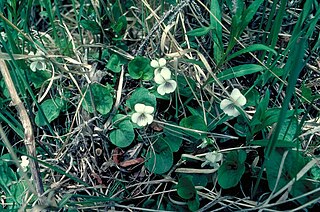
Viola renifolia is a species of violet known by the common names white violet and kidneyleaf violet. It is native to northern North America, where it has a widespread distribution across Canada and the northern United States as far south as Washington, Colorado, and New York.
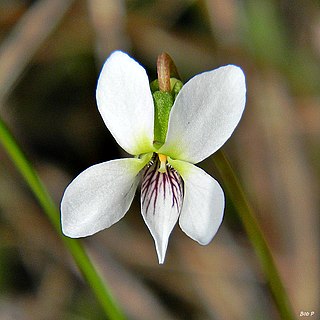
Viola lanceolata, commonly known as lance-leaved violet or bog white violet, is a small group of stemless white-flowered violets. It is an ornamental plant in the Violaceae family, part of the genus Viola. It gets its name from its lanceolate leaf shape and from the habitats in which it thrives.

Viola selkirkii is a species of violet known by the common names Selkirk's violet and great-spur violet. It is native throughout the Northern Hemisphere, its distribution circumboreal.

Viola brittoniana, known as coast violet, northern coastal violet and Britton's violet, is a rare, acaulescent blue-flowered violet that is endemic to the eastern United States. It has distinctive leaves with narrow lobes and deep sinuses. It is a perennial.

















